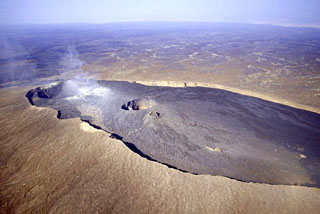Report on Erta Ale (Ethiopia) — January 2005
Bulletin of the Global Volcanism Network, vol. 30, no. 1 (January 2005)
Managing Editor: Richard Wunderman.
Erta Ale (Ethiopia) Hornitos on chilled lava lake surface in January 2005; December 2004 glass analyses
Please cite this report as:
Global Volcanism Program, 2005. Report on Erta Ale (Ethiopia) (Wunderman, R., ed.). Bulletin of the Global Volcanism Network, 30:1. Smithsonian Institution. https://doi.org/10.5479/si.GVP.BGVN200501-221080
Erta Ale
Ethiopia
13.601°N, 40.666°E; summit elev. 585 m
All times are local (unless otherwise noted)
An expedition led by the volcanology travel group SVE-SVG visited Erta Ale during 22-23 January 2005. The observed eruptive activity was generally unchanged since November 2004 (BGVN 29:11). Degassing was still occurring from three of the four hornitos in the SW part of the South crater, but had decreased slightly in comparison with their December 2004 observations. The hornitos stood ~ 10 m high and represented the only portion of the lava crust covering the crater floor where gas emissions were seen. A window in the upper part of one of the hornitos permitted observation of glowing molten lava.
On 23 January 2005 members of the group descended into the crater and collected recent lava that had poured out from the hornitos during partial collapse. Degassing activity (mainly SO2) from the North crater had also slightly decreased in comparison with early December 2004 observations.
From a small terrace in the NW part of the crater it was possible to observe degassing from several hornitos (some several meters high in the central part of the 'lava bulge'). Near the NW wall of the crater two small, red glowing areas were visible at the summit of two other hornitos.
Chemical analyses. The following complements a previous Erta Ale report by Jacques-Marie Bardintzeff from November-December 2004 (BGVN 29:11). He sampled molten lava at 12 m depth in one of the hornitos of the crater on 5 December 2004 using a cable and an iron mass, and subsequently analyzed the chilled glass sample using an electron microprobe (table 1).
Table 1. Major-element chemistry of Erta Ale lava resulting from 18 representative glass analyses. Courtesy of Jacques-Marie Bardintzeff.
| Oxide | Weight percent |
| SiO2 | 48.61-49.64 |
| Al2O3 | 12.99-13.60 |
| TiO2 | 2.37-2.66 |
| MgO | 6.13-6.39 |
| FeO | 11.25-12.20 |
| Cr2O | 0-0.11 |
| MnO | 0.03-0.34 |
| CaO | 10.63-11.41 |
| Na2O | 2.81-3.08 |
| K2O | 0.54-0.69 |
| Total | 97.44-98.71 |
Analysis also revealed some plagioclase phenocrysts (An = 80.9-70.4) as well as scarce clinopyroxene microcrysts (Wo = 43.5-44.0, En = 45.8-45.9, Fs = 10.2-10.6). Compared to the matrix glasses shown in table 1, glass inclusions trapped in plagioclase were richer in SiO2 (50.07-50.41 wt%) and poorer in TiO2 (1.84-1.95 wt %).
Correction. French scientists led by Jacques-Marie Bardintzeff and Franck Pothé visited the summit of Erta Ale on 13-14 January 2003 (BGVN 28:04). At that time the lava lake in the S pit crater was 180 m long, not 120 m as previously reported.
Geological Summary. The Erta Ale basaltic shield volcano in Ethiopia has a 50-km-wide edifice that rises more than 600 m from below sea level in the Danakil depression. The volcano includes a 0.7 x 1.6 km summit crater hosting steep-sided pit craters. Another larger 1.8 x 3.1 km wide depression elongated parallel to the trend of the Erta Ale range is located SE of the summit and is bounded by curvilinear fault scarps on the SE side. Basaltic lava flows from these fissures have poured into the caldera and locally overflowed its rim. The summit caldera usually also holds at least one long-term lava lake that has been active since at least 1967, and possibly since 1906. Recent fissure eruptions have occurred on the N flank.
Information Contacts: Jacques-Marie Bardintzeff, Laboratoire de Pétrographie-Volcanologie, Bât. 504, Université Paris-Sud, F-91405, Orsay, France (URL: http://www.lave-volcans.com/bardintzeff.html); Franck Pothé, Terra Incognita, CP 701, 36 quai Arloing 69256 Lyon Cédex, France; Henry Gaudru, Georges Kourounis, Derek Tessier, Brian Fletcher, Alexander Gerst, and Motomaro Shirao, Société Volcanologique Européenne (SVE)-Societe Volcanologique (SVG), Geneva, C.P.1, 1211 Geneva 17, Switzerland (URL: http://www.sveurop.org/).

